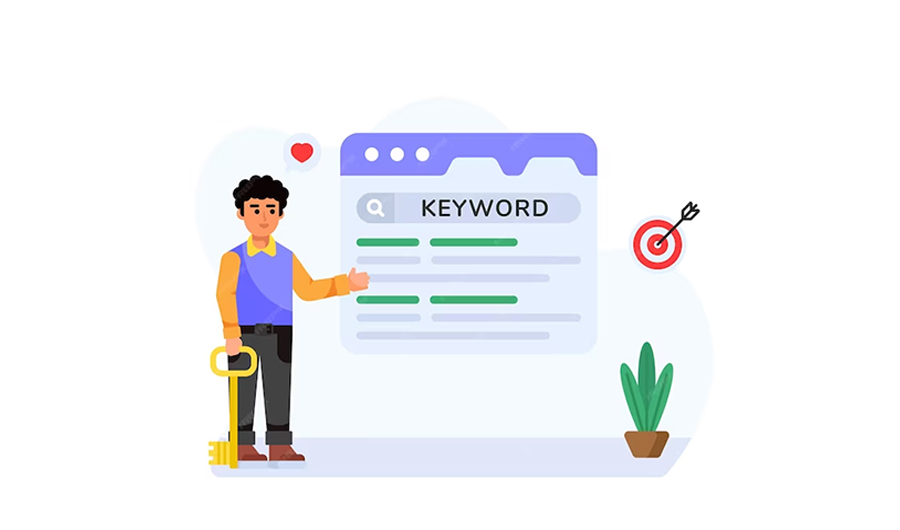
The Power of Keywords in SEO: Detailed Guide For 2024
What are Keywords in SEO?
The concepts and subjects that characterize your material are called keywords. Known as “search In the realm of SEO (Search Engine Optimization), “queries” refer to the specific words and phrases that individuals enter into search engines when seeking information or services. These queries are essential for understanding user intent and optimizing content to rank well in search engine results. These are your main keywords if you reduce everything on your page, including the writing, video, graphics, and so on, to just a few simple words or phrases.

As a website owner and content creator, your aim is to ensure that the keywords on your page closely align with what people are actively searching for. This tactic increases the chances of your content being discovered by users when they conduct online searches.
Why are keywords important for SEO?
Because they serve as the link between what people are searching for and the material you are offering to meet their needs, keywords are crucial. The purpose of ranking well in search results is to attract natural visitors to your website from the SERPs. The type of users you attract to your website will be determined by keywords you target, which includes the keywords you use in your content.
For example, if you run a golf shop, you might want to rank for “new clubs”; yet, if you don’t take precautions, you might draw visitors who are looking for a new spot to go dancing after dark.
Because you might describe what you give slightly differently than how your audience actually searches for it, keywords are just as much about your audience as they are about your content. You must comprehend the demands of your visitors, including the language they use and the kinds of material they are looking for, in order to produce content that ranks highly in search results and draws them to your website. Talking to your consumers, participating in forums and community groups, and conducting your own keyword research using a program like Keyword Explorer are some ways you can accomplish this.
What are long-tail keywords?
Keywords can be very general and widely used (often referred to as “head keywords” or “seed Keywords can take the form of single words (referred to as “short-tail keywords”), or they can be more specific and composed of multiple terms grouped together; these are known as “long-tail keywords.” known as “long-tail keywords.”
You may think that targeting and ranking for single keywords is the best course of action because these terms frequently have an enticingly high search volume, which indicates that more people are looking for them. They typically face fierce competition, though. For instance, you might want your boutique clothes business to appear in the search results for “clothes,” but it will be difficult to outrank sites like Amazon, H&M, and Nordstrom
Not only is there fierce competition, but singular keywords can be incredibly ambiguous. When someone searches for “dog,” you never know what they’re looking for—a list of dog breeds, details on dog food, a store where they can buy a collar, or just a website featuring adorable dog pictures.
Long-tail keywords typically have intent that is more obvious. For example, “best organic dog food for a puppy” and “inexpensive dog walkers in Seattle.” Long-tail keywords often present lower competition, making it easier to rank for them. Making it easier for a smaller website to get noticed and establish a presence in the SERPs.
Where to use keywords for SEO?
To begin, there are a few fundamental guidelines for keyword usage that you should abide by. In order to convince bots and humans that you have what they’re looking for, you should use unique keywords on every page of your website.
Your primary keywords should be strategically placed in the following key areas:
- Link tag titles
- Metadata synopsis
- Title of page (H1)
- Headings Below (H2)
- Body of the article
- Image Alt properties
After your content has been published, you can optimize a lot of these components. with the exception of the URL, which you should not alter.
A URL is your page’s web address; it appears in search results, is shown in the address bar, and is used to create links. Your target keywords should be included in URLs that are easy to read. Start with a straightforward and intelligible URL structure to save alterations later on.
Both the browser tab and the search results display title tags. It’s important to write them with humans in mind while also making them robot-friendly—a difficult balance to achieve! This is prime real estate, so you’ll need to practice being succinct and motivating clicks. This brings up a crucial point: clickbait’s drawbacks. You might think that by giving your content enticingly ambiguous titles, you’re driving more traffic, but in reality, you’re hiding the real purpose of the page and losing out on some of the SEO juice.
In addition to being shown in search results, meta descriptions are also known to influence user behavior and, in certain situations, can be altered by Google. Don’t forget to include your target keywords in the unique meta description that you write for every page. H1 tags appear on your page content and can assist in structuring your content so that humans can read it and so that robots can determine the relevancy of the topic.
Naturally, the keywords you’re targeting should appear in the body of your content. Simply sprinkling keywords throughout your page is not good. Producing engaging content that offers the user genuine value should be your aim.
Creating unique, accurate, high-quality content that engages users and sends strong signals to Google’s robot friends is often the most rewarding and time-consuming aspect of optimizing your content for target keywords.
Visual Although site owners frequently ignore it, alt text benefits users who are unable to view images and can also help by giving robots context for your images. The simplest method to direct searchers to your content is to include your keywords in these areas.
Although it won’t propel you to the top of the results right away, SEO is still very important, and skipping these simple steps could keep you from ranking higher through other channels.
Keyword Research Best Practices
Do keyword research to learn more about your target market and find keywords that are pertinent to your business.
Adapt your keywords to the intent of the user.
Employ your main keywords in title tags, H1 tags, on-page content, and, if possible, the page URL, meta description, and alt attributes. Obviously, you should only use keywords in relevant places; avoid stuffing them in irrelevant places!
Regularly conduct keyword research to stay up to date with trends.
Use keywords to formulate a content strategy
Although it’s common practice to begin with a keyword and build a piece of content around it, there are instances when your content already exists and you need to find ways to align it with keywords. To accomplish this, make a “content to keyword map.” Making this map will assist you in assessing the effectiveness of your current content and locating any gaps or weak points that require attention.
You can use keywords to structure your content and create a plan because they define each page on your website. The simplest method for accomplishing this is to create a spreadsheet (also known as a “content to keyword map”) and list the main keyword for every article. After that, you can customize your sheet to your exact specifications and include metrics such as page authority, organic traffic, keyword search volume, and any other important metrics for your company.
Ideally, every page on your website should focus on a different main keyword. Typically, your homepage will focus on a wide range of industry terms. As you develop category pages, product pages, and articles, they will delve deeper into your niche and address more particular requirements.






